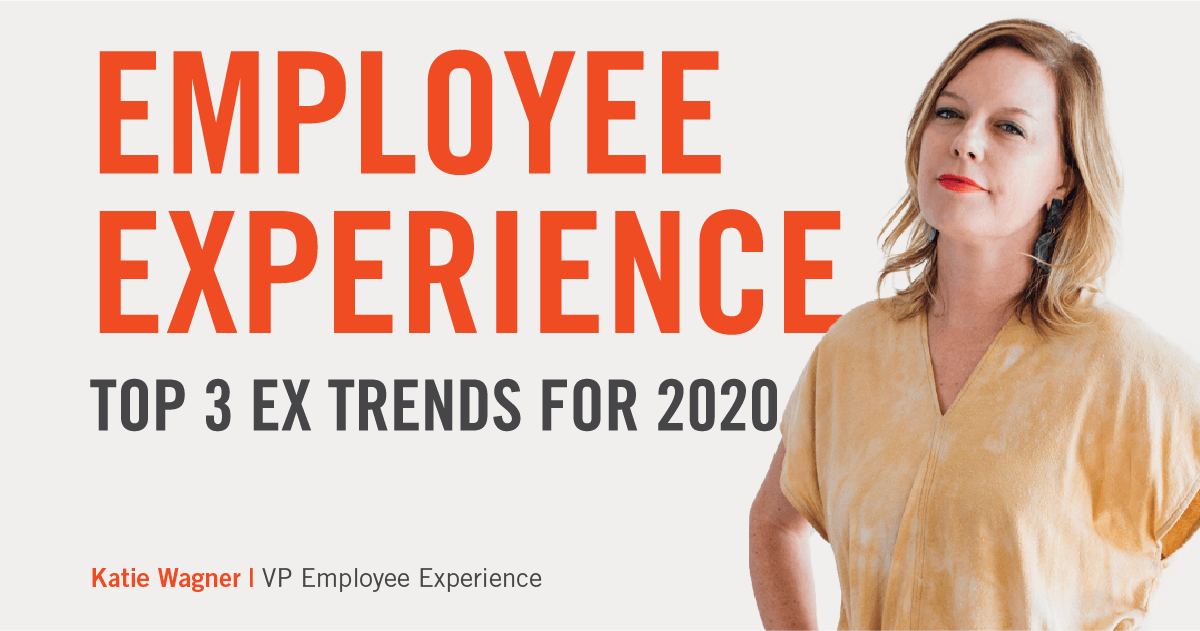Top 3 Employee Experience Trends for 2020
Let’s get right to it: in 2020, organizations will make significant investments in employee experiences to recruit and retain talent who will best deliver on the company’s brand.

Top EX trends to watch in 2020
In today’s white-hot labor market, it’s no longer enough to simply keep enough people around to get the job done. It’s now more vital to get the right people doing the right jobs with the right mindset. Companies are going to be choosier in who they hire and who they retain, and will invest smarter and in a more targeted way.
Too often, companies end up chasing after their own employees, hoping to reach and connect with everyone to create alignment with what the company needs from them. If there are employees not truly invested in the organization’s success, they often end up needing more attention while underperforming. This results in wasted time, resources, and lost revenue, which could ultimately cause damage to the company.
What follows are some of the trends for 2020 that we believe will drive this refocused investment in employee experience.
In 2020, companies will make it clear what they truly believe in.
#1 Employees Value Clarity
In order to thrive, more companies will both memorialize what they stand for from a values, purpose, and employee value proposition (EVP) perspective and activate it with more intention. This will help companies recruit and retain those employees who best align with the company’s brand and beliefs.
With a war for talent going on, employees no longer feel they have to work for a company that doesn’t articulate what it stands for and/or align with their own belief systems. In addition, employees don’t feel like they need to stay quiet about how they feel about their company. To retain and recruit the talent who is aligned with the company, companies will have to ask (and answer) themselves a vital question:
What is the value of working here beyond the paycheck?
The answer isn’t simple because it has to be looked at through multiple lenses—and that brings clarity for both the organization and the employee. What is the purpose of the organization? How does it live its values? How does the work I do play a role? And, what does opportunity look like here? The answers to these questions will help both the company and the talent understand if they are aligned as to expectations for what is necessary for both to be successful.
Once the value proposition (and all its ingredients) are clearly articulated, it’s on the company to then hire and retain those people who are aligned with the company. You can’t be everything to everybody, so be true to who you are. Amazon will continue to seek and retain people aligned with their customer-centric, achievement-driven culture. They aren’t going to change their workplace to be something different to quiet the naysayers and make everyone happy.
All this is to say that by understanding and expressing outwardly the ultimate value of working at their organization, companies will be able to better identify, recruit, and retain workers that align with the company they work for. Companies are realizing this, and in 2020, even more companies will show up so that employees know who they are working for and what is expected of them.
Developing their own employees will be a big priority for companies everywhere.
#2 Train to Retain Employees
In 2020, organizations will make significant investments to upskill employees they need to be successful. When you find the people you want, you want to keep them around. This increasingly means helping them develop the skills they need to succeed (and stay).
It’s hard enough to identify and recruit the kind of workers you need to reach the goals you’ve set as a company. The last thing you want to see is them walking away because you didn’t provide more growth opportunities internally.
This means rewarding those employees that are both aligned with the brand’s beliefs and have a growth mindset—meaning they want to and will take advantage of development opportunities offered to them.
But it also means being willing to part with those workers who aren’t interested in growing. Over time, employees who show no interest in adapting to the inevitable changes going on around them can weigh a company down.
This is especially true when it comes to digital transformation. The speed of tech far surpasses the speed of business. To even come close to keeping up, most companies must upskill internally.
There simply aren’t enough advanced tech-trained prospects on the open job market to fill the gaps, so companies will continue to seek ways to satisfy those needs from the inside. As blue-collar labor jobs turn into white-collar jobs managing automation, this fact becomes even clearer. To keep pace with the change going on, whether they like it or not, companies will have to invest the necessary resources and energy on skill development.
Making that investment will boost your company’s business results as well. A culture of skilled workers who are aligned with the brand and see the value of working at the company will inevitably result in both higher productivity and higher retention.
Elevating employee experiences to the next level will be key in 2020.
3 (Employee) Experience Matters
Companies will make a greater effort to align their employee experience with their customer experience because both audiences are integral to a company’s success.
For years, companies have invested in both their brand and customer experiences, and all but ignored the experiences that their employees have with the company. This has resulted in many employees thinking their own companies are not committed to being as leading edge as they say they are to their own customers and many customers having a disjointed experience with the brand.
Delivering experiences (especially from a technology and workplace design perspective) that support employees in the same way that companies do with consumers is something every company should strive to do. Companies need to remember their employees are consumers too. So, they are expecting to have some of the same experiences that they have as a consumer—especially if it helps them get their jobs done.
“Consumer-grade” employee experiences are essential for employees to be effective in their roles and for companies to stay competitive in today’s market.
To achieve “consumer-grade” employee experiences, companies need to examine every element of their experience that the company can affect to understand how it should change. A good filter to assess what experiences should change is to use the company’s own experience principles that it uses with its own customers. Experiences that companies should assess could include:
• Internal communication mediums and channels
• Technology and tools
• Physical and digital workspaces
For example, nearly everyone today inputs and outputs information the same way in their personal lives, through AI-driven, personalized, user-friendly technology. We use phones that are smart, tell computers in our houses to perform basic tasks, and rely on algorithms to tell us what we might enjoy. Work should be no different.
Alignment of a company’s employee experience and customer experience is driven in large part by the changing expectations of workers, especially those under 40 who are starting their careers. Companies that deliver the same experience to their employees as they do their customers will be more successful. Those that can’t, or won’t, will not be.
In 2020, the choices many business leaders make will reflect a renewed focus on employee experiences and a dedicated investment in the futures of their employees so that they see the value of working for the company.
The time to design your employee experience to recruit and retain essential talent is now. Let’s talk and let us help get you started!
Author: Katie Wagner VP of Employee Experience
 Katie’s passion and experience in building authentic brands has enabled her to serve in a trusted agency-side role as part practice lead, part agency team leader and overall strategic advisor. She draws on her diverse background to ensure that the agency is doing the right work in support of culture design and employee experience, so that it resonates with her clients’ brand objectives and positively impacts their employees, customers and business. Read Katie’s full bio here.
Katie’s passion and experience in building authentic brands has enabled her to serve in a trusted agency-side role as part practice lead, part agency team leader and overall strategic advisor. She draws on her diverse background to ensure that the agency is doing the right work in support of culture design and employee experience, so that it resonates with her clients’ brand objectives and positively impacts their employees, customers and business. Read Katie’s full bio here.

